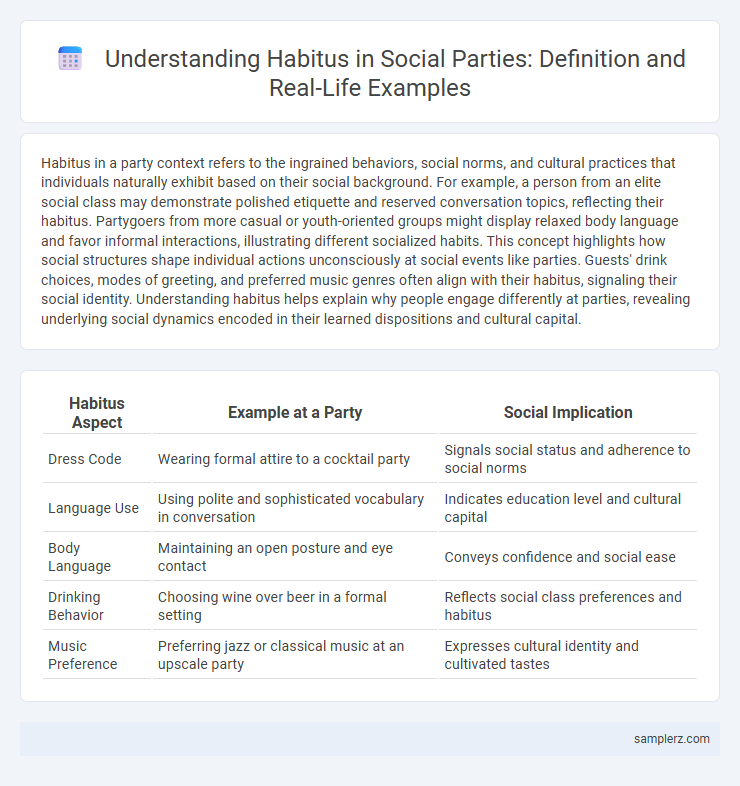Habitus in a party context refers to the ingrained behaviors, social norms, and cultural practices that individuals naturally exhibit based on their social background. For example, a person from an elite social class may demonstrate polished etiquette and reserved conversation topics, reflecting their habitus. Partygoers from more casual or youth-oriented groups might display relaxed body language and favor informal interactions, illustrating different socialized habits. This concept highlights how social structures shape individual actions unconsciously at social events like parties. Guests' drink choices, modes of greeting, and preferred music genres often align with their habitus, signaling their social identity. Understanding habitus helps explain why people engage differently at parties, revealing underlying social dynamics encoded in their learned dispositions and cultural capital.
Table of Comparison
| Habitus Aspect | Example at a Party | Social Implication |
|---|---|---|
| Dress Code | Wearing formal attire to a cocktail party | Signals social status and adherence to social norms |
| Language Use | Using polite and sophisticated vocabulary in conversation | Indicates education level and cultural capital |
| Body Language | Maintaining an open posture and eye contact | Conveys confidence and social ease |
| Drinking Behavior | Choosing wine over beer in a formal setting | Reflects social class preferences and habitus |
| Music Preference | Preferring jazz or classical music at an upscale party | Expresses cultural identity and cultivated tastes |
Introduction: Understanding Habitus in Social Gatherings
Habitus in social gatherings shapes individuals' behaviors, preferences, and interactions based on ingrained dispositions influenced by their social backgrounds. At a party, habitus manifests in choices of conversation topics, seating preferences, and forms of self-presentation, reflecting underlying cultural capital. These patterns reveal how social norms and past experiences implicitly guide participants' engagement and social positioning within the event.
Dress Codes: How Attire Reflects Social Background
Dress codes at parties often reveal underlying social habitus by signaling an individual's cultural capital and social status. Attire choices, such as designer labels or vintage pieces, communicate group membership and adherence to specific social norms. These sartorial decisions function as non-verbal cues that reinforce social distinctions based on class and identity.
Conversational Styles: Speech Patterns in Party Settings
Conversational styles at parties often reflect the habitus of attendees, with speech patterns varying based on social background and cultural capital. For instance, informal, rapid exchanges filled with slang and humor tend to dominate youth parties, signaling group belonging and shared values. In contrast, upscale gatherings exhibit more polished, formal language and measured turn-taking, highlighting status and fostering exclusive social bonds.
Food Choices: Culinary Preferences and Class Distinctions
Food choices at parties often reveal underlying social class distinctions, as individuals select dishes that align with their cultural capital and perceived sophistication. For example, guests from higher social classes may prefer gourmet foods like artisanal cheeses and organic wines, reflecting their habitus shaped by access to exclusive culinary experiences. In contrast, attendees from working-class backgrounds might opt for more traditional or comfort foods, reinforcing class identities through shared culinary preferences.
Body Language: Nonverbal Cues of Social Position
In social parties, habitus is evident through body language such as posture, eye contact, and gestures that signal social position and confidence. Individuals from higher social strata often display open, relaxed stances and direct eye contact, while those from lower positions may adopt closed or reserved postures. These nonverbal cues subtly reinforce hierarchical structures and influence interpersonal dynamics within the social setting.
Networking: Forming Connections Based on Shared Habitus
At a party, networking often revolves around forming connections based on shared habitus, such as common interests, cultural backgrounds, or professional fields. These shared dispositions shape conversations and help individuals quickly establish rapport and trust. Understanding the habitus of others enables smoother social interactions and more meaningful relationships within the networking context.
Participation in Activities: Who Joins In and Why
In social parties, habitus influences participation by shaping individuals' comfort levels and interests, guiding who joins in various activities like dancing or games. Those with a habitus aligned to social engagement and expressive behavior tend to participate more actively, driven by ingrained dispositions toward sociability. Conversely, individuals with a more reserved habitus may observe rather than join, reflecting underlying cultural and social conditioning.
Music Preferences: Cultural Capital on the Playlist
Music preferences at parties reflect individuals' cultural capital, shaping social interactions and group dynamics. Guests often curate playlists featuring genres like jazz, indie rock, or electronic music, signaling their tastes and social status within the group. These musical choices reinforce habitus by aligning with participants' lifestyle, education, and class background.
Hosting Etiquette: Displaying Socialized Norms
Hosting etiquette at a party exemplifies habitus by reflecting deeply ingrained social norms such as welcoming guests promptly, offering appropriate refreshments, and facilitating engaging conversation. These behaviors demonstrate an internalized understanding of social expectations, reinforcing group cohesion and status recognition. The consistent practice of such rituals highlights the unconscious cultural competence individuals possess within their social milieu.
Group Formation: Social Circles and Inclusion Dynamics
In party settings, habitus shapes group formation by influencing social circles through shared cultural norms, behaviors, and tastes that signal belonging. Individuals gravitate towards others with similar social capital, fostering inclusion dynamics that reinforce existing hierarchies and exclusivity. This process creates stable yet fluid social networks where insiders and outsiders are clearly delineated by habitual practices and interaction styles.

example of habitus in party Infographic
 samplerz.com
samplerz.com